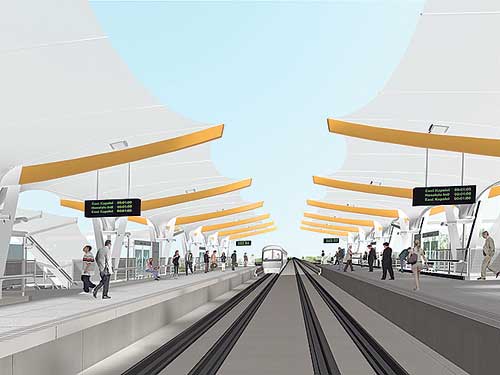‘Yes’ to transit authority

For 40 years, rail transit for Oahu has been debated, studied, rejected, planned for, planned against, anguished over, voted on and finally approved. Now comes the hard part.
Barring extraordinary circumstances, work on Hawaii’s biggest public works project — a 20-mile, $5.5 billion guideway that will change the way Oahu residents commute between Kapolei and downtown — will proceed. And Honolulu voters have a chance to decide how this massive project will be managed.
Question No. 1 on the Nov. 2 ballot reads, "Shall the revised City Charter be amended to create a semi-autonomous public transit authority responsible for the planning, construction, operation, maintenance, and expansion of the city’s fixed guideway mass transit system?"
Voters should choose "Yes."
The engineering, design and construction challenges will be unprecedented for Hawaii. The rail system will traverse, literally and figuratively, a landscape fraught with political landmines: vacant farmland on the Leeward side, urban areas now occupied by homes and businesses, potential iwi burial sites in Kakaako.
A transit authority, with its semi-autonomy and singular focus, can respond to these inevitable hurdles far more efficiently than the current management structure, without eliminating reasonable safeguards for transparency and public input. Among its key components:
Don't miss out on what's happening!
Stay in touch with breaking news, as it happens, conveniently in your email inbox. It's FREE!
ON THE WEB» Last week’s general election endorsements — including governor Opens in a new tab, Congress Opens in a new tab, OHA Opens in a new tab and school board Opens in a new tab. For more on all candidates and the Nov. 2 election, click on the website’s "VOTE 2010" election guide icon Opens in a new tab. » To view candidates on video, see www.olelo.org/whatson_vote_cif.htm Opens in a new tab. |
» Leadership: The authority would be overseen by a 10-member board of directors including the state director of transportation, the city director of transportation services, three members selected by the City Council and three by the mayor, plus a ninth member selected by the first eight; the 10th member would be the city director of the Department of Planning and Permitting, who would not have a vote.
» Management: An executive director, appointed by the board, and supporting staff — mostly the city employees already working on rail — would comprise the front lines of the transit authority.
» General powers: The authority could obtain property needed for the rail project, including condemning property through eminent domain, provided the City Council does not act within 45 days to stop it. The authority could also make and execute contracts, issue revenue bonds with Council approval, set fares and otherwise handle all aspects of the construction and management of the rail system.
The authority would not have unlimited powers. The City Council would have to approve the authority’s budgets, its eminent domain decisions and bond sales. Public hearings would be required for the authority’s budget and fare adjustments. The authority’s accounts and financial status would be audited every year.
Even so, accountability is a concern. A project this size must invite scrutiny of how the billions of dollars are spent. Elected officials may find it tempting to hide behind the authority’s quasi-autonomous status to avoid taking responsibility for the inevitable problems that arise. Those who run the authority, the elected officials who ultimately oversee them and the private contractors and unions who contract with them should expect and welcome full public disclosure of the authority’s activities. With that understanding, Oahu voters should approve creation of the transit authority.
Other City Charter amendment questions of interest to Honolulu voters include:
Question 2: This tightening of conflict-of-interest rules would restrict a newly appointed city department head’s ability to make decisions using information gained from that person’s previous employer.
Question 3: This is an attempt to strengthen the Liquor Commission’s oversight, giving it more authority to hire or fire its administrator and deputy administrator.
Question 4: This clarifies inconsistent language in rules governing the public initiative process for creating new city ordinances.
Question 5: This would liberalize the city’s rules in disposing of personal property.
Question 6: This would create a city office of housing to address affordable, senior and special needs housing and homelessness. The Star-Advertiser has endorsed this amendment Opens in a new tab.
For more information, go online to www.honoluluelections.org Opens in a new tab and click on the "2010 Proposed Charter Amendment" link.



